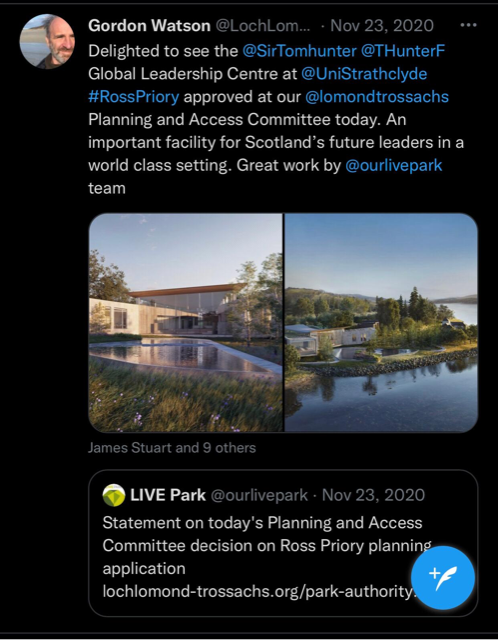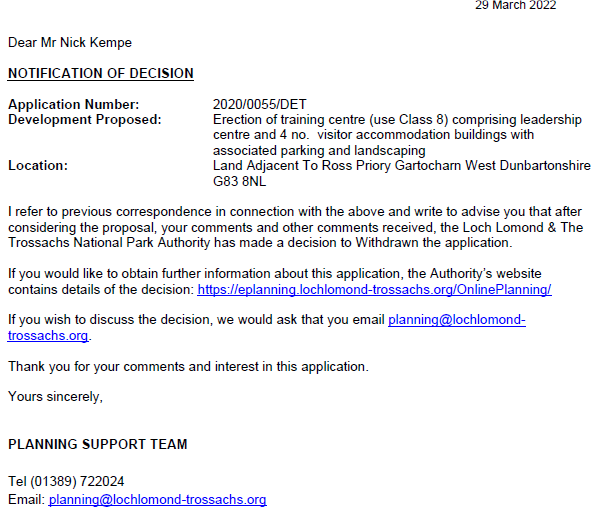[I started drafting this post a month ago before my unanticipated lay off (see here). It may no longer be news but what has happened has implications for the Loch Lomond and Trossachs National Park Authority].
On 22nd March The Hunter Foundation (THF) wrote to the Loch Lomond and Trossachs National Park Authority (LLTNPA) (see here) withdrawing their misconceived and inappropriate plans for a “global leadership” centre at Ross Priory. The next day THF announced (see here) that it had bought Blair Castle in Ayrshire “as its new headquarters and home to all its leadership programmes”. Having opposed the development (see here, here and here), in my view THF’s decision is most welcome.
Blair Castle is a far more appropriate location, making use of an existing building rather than an undeveloped south-east shore of Loch Lomond, is relatively close to public transport (Dalry station is less than a mile away) and offers opportunities for THF to show real leadership and demonstrate how historic buildings can be made carbon neutral.
The LLTNPA’s response to the application and its withdrawal

After their Planning Committee ignored all the well-founded objections to the development and gave it the go-ahead, the leadership of the LLTNPA could not contain their delight. Besides twitter, the LLTNPA issued a short news release (see here) which, after claiming how careful and balanced they had been through the decision-making process, concluded:
“The application was for a unique facility of the highest architectural quality that will help secure the future of Ross Priory and its estate in the longer term but broadening its use providing huge benefits for both the National Park and for Scotland.”
Contrast this with the LLTNPA’s response to the withdrawal. Six weeks later there has been no news release and it took six days for the LLTNPA to post THF’s letter on their planning portal. The next day the LLTNPA sent out an extraordinary letter, unsigned and unchecked, to people who had commented on the application claiming that the LLTNPA “has made a decision to Withdrawn (sic) this application”:

Later the same day the LLTNPA sent out another email which stated “Please delete the previous email which was sent to you earlier this morning with the wrong letter attached, due to an administrative error. We apologise for any inconvenience.”
The wrong letter? Surely an example of more incompetence (see here)! That is not, I believe, an accident. The leadership of the LLTNPA take no ownership of basic issues and expect their staff to fix the shambles they have created, hence errors such as this.
One explanation for this public relations disaster – another allegedly world class development not happening – is that the gleam of an award for services to empire, whether OBE or MBE, was too much for the leadership team at the LLTNPA to resist. Then, when that prospect disappeared, they were left in complete disarray.
The reasons for THF’s withdrawal
Had the LLTNPA been true to their own policies and the statutory objectives of Scotland’s National Parks when initially approached by the THF about the proposed development they would either have advised them to renovate Ross Priory – which is still desperately in need of attention – or directed them elsewhere. Instead they enticed THF into a lengthy planning process which THF have used to justify withdrawing from the proposed development: “the timescales on this have, to be frank, been incredibly onerous”.
THF has got it wrong, however, in claiming in their letter that the delays were not due to the LLTNPA’s assessment but rather to general planning processes. The reason the processes were so onerous and lengthy was in large because the LLTNPA had encouraged THF to proceed with an application which was inappropriate. The LLTNPA therefore required THF to produce large amounts of paperwork, produced by expensive consultants, and to keep changing its plans in order to allow the National Park to get around its own policies.
Added to that was the LLTNPA’s failure to require an Environmental Impact Assessment (EIA) BEFORE giving THF the go-ahead to produce detailed plans. An EIA would have identified, for example, that a loch shore development would pose serious problems in terms of sewerage and waste water disposal. But instead of this being clear from the start, 10 weeks into the planning process an objection from the Scottish Environment Protection Agency forced THF into abandoning their proposal for a reedbed and to develop an expensive proposal to pump waste up to the Scottish Water treatment works at Gartocharn.
The LLTNPA only published a screening opinion, dated 30th October 2020, stating that an EIA was not necessary on 11th November, twelve days before the Planning Committee took place. The failure to conduct a proper EIA resulted in an appeal to the Scottish Government from local Councillor, Sally Page. This delayed the planning process by another couple of months but should have put an end it to if there was any justice.
Among the incredible logic used by Scottish Government officials to determine that an EIA was not required was the statement that “the decision [by the LLTNPA] to consider the proposal as an urban development project [which they did to avoid admitting they had made a serious mistake] is not an unreasonable one.” This was for a development on the unspoiled shores of Loch Lomond several miles from Balloch. It would appear that nowhere in the National Park is now safe from urban style developments but particularly when a developer like THF is a close partner of the Scottish Government (see here).
Local communities may have more influence than may sometimes appear
Almost no-one in the local community around Gartocharn (apart possibly from LLTNPA Chief Executive Gordon Watson who lives there) appears to have supported the proposed development. During the planning process the LLTNPA simply rode roughshod over their concerns, whether this was reports of nesting ospreys – missed by the environmental surveys – increased traffic or a sense of place (in this case a quiet corner of the National Park). Environment, transport and place are all now meant to drive all planning policy.
On top of this THF’s proposed development offered almost no benefits to the local community that might have won some people over to their proposals. A paltry amount was promised to Ross Priory, which is valued locally, but that was it.
While the local community formally failed to prevent the LLTNPA from approving the planning application, they have won in the end. It appears that THF may have eventually realised that without community support the development could have disastrous consequences for them as an organisation and this helped them decide to abandon the proposal. How can an organisation profess to offer global leadership while ignoring its impact on local communities?
What needs to happen
As yet there is no sign that the LLTNPA Board is going to consider what went wrong with the THF planning application or proposed development, let alone what it needs to do to address the very real issues surrounding Ross Priory and how the building and cultural landscape could be conserved in future. They now need to so.
But they also need to start taking a far more robust approach to spatial planning in the National Park. More specifically they need to make a stand against further developments on the loch shores in the National Park, including the southern half of Loch Lomond, which are irresistible to developers. The LLTNPA need to end the current situation where developers like THF think they can buy a view. The National Park should be for all.
It is all very well the LLTNPA having an ostensible presumption against new developments in rural areas and constraints on developments in settlements, but there are so many exceptions to these in its policies that almost any development can be justified. The developers know this and, as a result, keep coming, encouraged by senior managers who are so dazzled by power and money that they have little hesitation in using those exceptions to enable developments go ahead.
THF may have seen sense at Ross Priory but similar issues are being repeated at Inchconnachan (see here) while the return of Flamingo Land at Balloch appears imminent. Until the LLTNPA starts acting like a National Park and protecting places like Loch Lomond, it will continue to let down the people of Scotland.
An excellent post Nick exposing, once again, the incompetence of this shambles of an authority.
I am watching closely for the decision whether to make Galloway the next National Park. If it goes ahead we can only hope that it is managed better than the existing two Parks.
Rather than an MBE, I wonder if the planners were hoping for another accolade along the lines of the one they were given for Ripple Retreat on Loch Venachar.
Same architect, and similar ‘principles’.
The thing that really wound me up about this whole thing is just how disinterested the Hunter Foundation and Planning Department were in the views of the local community, only then to constantly repeat (and use as a justification) that the project was ‘for the good of the nation’.
I doubt they’ve learnt anything from this though.
Where is ‘planning’ in all of this? If sites like this are to be developed there has to be a policy in the Local Plan, based on due process. Making it up as you go along is not planning!
I too received the botched notification from LLTTNPA. Interestingly enough, despite the Approval by the LLTTNPA Planning and Access Committee for the application by Tom, as he was called by the Planning and Access Committee whereas others were Mr or Mrs,, the application’s STATUS on the LLTTNPA planning portal right up to the issue of the withdrawal notification was CURRENT.